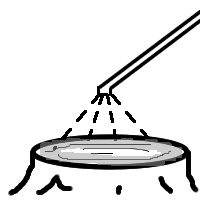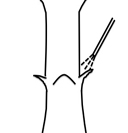| Select-A-Herb uses several abbreviations and words that may require definition. Below are several words and abbreviations that you may encounter in these tools. |
| |
|
|
|
|
A - B - C - D - E - F - G - H - I - J - K - L - M - O - P - Q - R - S - T - X - U - V - W - X - Y - Z |
| |
|
|
|
a.e. |
This is an abbreviation for "acid equivalent". The active ingredients of several herbicides can be formulated in several different ways. In some cases, the active ingredient is formulated as a salt. This allows the herbicide ingredients to go into the water better or aids in absorption (moving into the plant). When comparing different products with the same active ingredient, a.e is often used to refer to the basic herbicide molecule. |
| |
|
|
|
|
| |
ai |
The abbreviation 'ai' is used for "active ingredient". This is the component of the herbicide that has herbicidal activity. This active ingredient may be formulated in several different ways. Many herbicides come with inert ingredients that aid in absorption, mixing, etc. These inert ingredients are not included when "ai" is used. |
| |
|
|
|
|
|
Basal |
A basal application or often referred to as basal bark application is the application of a herbicide to the lower 18 inches of a woody stem or tree trunk. The herbicide soaks through the bark and into the cambium layer. This is a common application method used to control woody species. |
|
| |
|
|
|
|
| |
Broadcast |
A broadcast application is an application where the herbicide is applied indiscriminately over the vegetation. In many cases, this involves a boom and tractor application equipment. All species susceptible to the herbicides being applied can be damaged. |
| |
|
|
|
|
|
Cut Stump |
A cut stump application is when the herbicide is applied to the cut surface of the stump of a tree or shrub. It is most effective when the stem is sprayed within 1 hour of cutting. In the case of woody species, it is imperative that the herbicide is applied to the cambium layer. This is an outer ring just under the bark which contains most of the tree's vascular tissue (gray area in figure). |
 |
| |
|
|
|
Girdle & Frill |
A herbicide application were cuts are made at 1-inch intervals around the stem of a woody plant then a herbicide is sprayed into the open cuts. This introduces the herbicide to the woody species' cambium layer. |
 |
| |
Gal |
An abreviation for gallons |
|
fl oz/A |
Fluid ounces per acre |
|
Hand-Held |
Spot and foliar applications are made with spray canisters and/or backpack application equipment. Herbicide is generally applied to foliage. Foliage is generally thoroughly covered but not to the point where it starts to run off the leaves. |
| |
|
|
|
|
|
Injection |
This application procedure uses specific equipment designed to inject the herbicide directly into the plant. It is most commonly used for woody plants, trees, and shrubs. In most cases, it is recommended that the injections be done around the tree at 1-inch intervals. |
| |
|
|
|
POST |
The abbreviation of postemergence. An application is performed after either the emergence of the weed or crop. If it appears in the 'Site Timing' column then it refers to before the crop or desired plant. If it appears in the 'weed size' column then it refers to what you are trying to control. |
| |
|
|
|
|
| |
PRE |
An abbreviation of preemergence. An application is performed before either the emergence of the weed or crop. If it appears in the 'Site Timing' column then it refers to the crop or what you are wishing to grow. If it appears in the 'weed size' column then it refers to what you are trying to control. |
| |
|
|
|
|
|
Spot |
These applications are done on isolated small areas. Some labels specify that 1/10 of an acre constitutes a 'spot' application. They are often applied by backpacks or sprayers mounted on all-terrain vehicles. In most cases labels will provide a volume to volume (v/v) percent rate. In other cases, a per acre rate may be provided. |
| |
|
|
|
|
|
v/v |
Some labels provide rates in volume per volume quantities. |
Example: A 3% v/v allows you to calculate the amount depending on how much carrier volume you are using. If you are using a 2-gallon mix do the following:
3% divided by 100 = 0.03, so 0.03 x 2 gallons = 0.06 gal, which is (0.06 x 128 = 7.68) 7.68 floz in 2 gal. |
| |
|
|
|
|